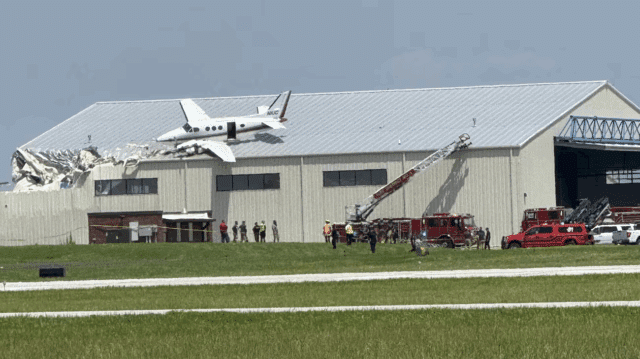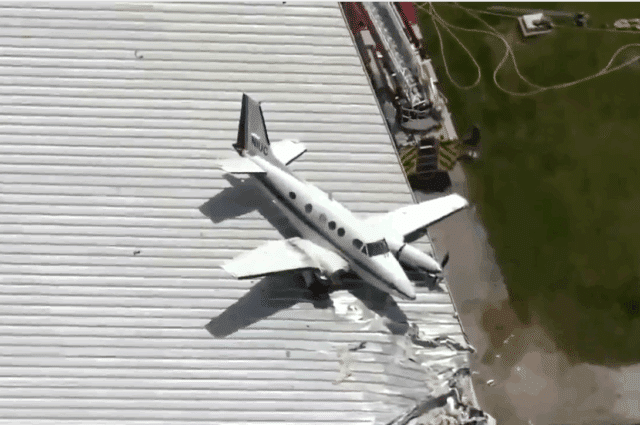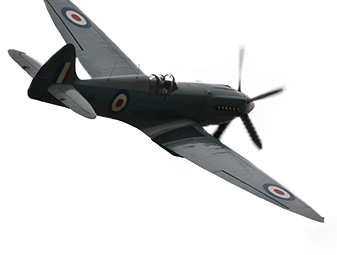King on a Hot Tin Roof
On Monday the 16th of June 2025, a twin-engine plane crashed onto the roof of a hangar.

The aircraft was a 50-year-old Beechcraft King Air E-90, registered in the US as N1UC (serial number LW-140) with a valid airworthiness certificate until June 2031. At the time of the accident, the King Air had 10,922 total airframe hours and 9,505 cycles. The pilot holds an Airline Transport Pilot certificate, the highest level of pilot certification issued by the FAA, with an ATP rating for Airplane Multi-engine Land such as the King Air. He holds type ratings for a wide range of complex aircraft including the Airbus A320, Boeing 727 and 747, the Beechjet 400, the Cessna Citation 500 and others. Although his flight hours have not been released, they likely exceed that of the King Air.
The flight departed normally from Missouri, where the pilot is based, for a short private flight to New Century AirCenter in Gardner, Kansas. (Fox News reported that flight originated from Butler Municipal Airport, which caused me a good 20 minutes of confusion, as Butler Municipal Airport is in Georgia. The flight actually departed from Butler Memorial Airport (KBUM), which is located in Missouri.)
There were two on board: the pilot and one passenger. The weather in Kansas was warm with light winds and broken clouds at 3,400 feet. They were in the final phase of their flight, flying south on approach to runway 18 at New Century AirCenter.
The data on ADS-B Exchange shows that the King Air had slowed to 140 knots for the approach as it crossed the freeway. According to early reports, the left engine failed.
With the right engine still producing power, the King Air veered to the left, still descending. At about 13:15 local time, the plane crash-landed onto the roof of the Butler Avionics hangar.

(Butler Avionics bears no connection to Butler Memorial Airport or Butler Municipal Airport, but changed its name from King Avionics to Butler Avionics after it was acquired by the Butler National Corporation in 2010. Butler National Corporation also has nothing to do with Butler Memorial Airport or Butler Municipal Airport but took the name in 1960 after the National Connector Corporation merged with an aviation research firm owned by the Butler family. Herewith endeth my brief obsession with all the Butler references in this case.)
The pilot is said to have then lost control of the aircraft but it sure looks like he managed to flare as the King Air clearly came down on top of the hangar roof as opposed to crashing into it. It seems like the aircraft must have spun almost 180° as they impacted, likely the propeller of the working right engine digging into the roof.
First responders quickly arrived on the scene, including the Johnson County Sheriff’s Office, Kansas Highway Patrol, Fire District #1, and MED-ACT.
The firefighters from Fire District #1 set up a ladder to reach the roof and laid down foam suppressant as fuel was leaking into the hangar below. The pilot and his passenger were able to release their safety restraints and climb out of the aircraft, with firefighters quickly concluding that they had only “non-life-threatening injuries”. Fire crews helped the two down from the roof and transported them to a nearby hospital for treatment of minor injuries. None of the workers inside the hangar was injured, although that must have been quite a shock! The airport closed to traffic for about an hour but there was very little disruption to operations.
This 90-second clip showing aerial footage of airport and the hangar was posted to a Russian-language aviation channel on Telegram.
2025.06.16. Emergency landing of Beechcraft E90 King Air N1UC on the roof of a hangar at New Century AirCenter (JCI/KIXD), Kansas state. The aircraft lost power in the left engine and as a result fell onto the hangar roof during approach to runway 18. The pilot (73) and his passenger (30) received minor, non-life-threatening injuries. ABC News by KMBC
This video isn’t from ABC News, so I think the credit refers to where the crash information was sourced, rather than the video itself. However, I think it might be the full video from News Chopper 9, based on this excerpt posted on KMBC 9’s YouTube channel.
The hangar stood up relatively well to being landed on with a King Air. Truthfully, the King Air could not have picked a better place to land, as Butler Avionics specialise in King Air maintenance and repair.
Kansas Highway Patrol filed a report that a vehicle crashed into a building (“Hit and Run: No”) 500 feet west of Old U56. According to the crash log, a mechanical malfunction caused the left engine to become inoperable.
So far no CCTV or ATC recordings from the incident have been released. A poster from the local area on the r/aviation subreddit said that they were cleared to land on Runway 18 but then called for a go-around due to the failure of the left engine.
Another poster attempted to assess the damage:
Looks like the left wing is a little wonky. The left engine is totally fubar. The right engine looks equally fooked. The gear probably won’t hold the weight anymore. Fuselage skin needs exfoliation and a shit ton of moisturizer.
Another comment on the subject was from an A&P mechanic
Honestly, kudos to the guys at Beechcraft. I would not have expected an aluminum plane to seemingly win in a fight with a steel building, but that King Air looks like it could be made airworthy again.
Full credit to the hangar as well, which stood firm, supporting the King Air 90 and protecting those underneath.
There is not yet any information on what happened to the left engine, one of two Pratt & Whitney Canada PT6A turboprop engines equipped with Raisbeck four-bladed propellers. Juan Brown reports that the left engine was not feathered, which should be an instinctive reaction in the event of an engine failure, although he also added that one blade “looks like it’s nearly twisted into the feathered condition”.
Juan Brown believes that a key point for the investigation will be to ascertain whether this was an actual engine failure or a practice single-engine approach. He says that the King Air was travelling at 86-87 knots before crashing into the hangar while the minimum control speed for the King Air with an engine inoperative (Vmc) is 86 knots, so it is not clear to me why the very experienced pilot lost control. Juan Brown further reports that the aircraft was travelling at 81 knots at time of impact, but this seems to be based on ADS-B data which is notoriously unreliable at low level.
Bryan Johnson, the executive director of the Johnson County Airport Commission, expressed relief that no one was seriously injured.
Anytime the call goes out that a plane goes into a hangar building, it stings a bit. But again that’s why you’ve got professionals to address the immediate needs of those on the aircraft and make sure everyone’s safe on the ground too.
The airport staff have reported that they are collaborating with the NTSB and the FAA for a formal investigation into the cause of the crash.
Full credit to @jpdemer5 who commented on Youtube with “King on a Hot Tin Roof” which I promptly stole to use as the title of this post.








Both pilot seat cushions are missing and replaced with feces. — the remainder of the reddit quote
:D
So the timeline is a little hazy… if the engine failed just before the threshold, surprising the pilot, and they were pretty much at Vmc, I can see this happening. I’m sure you’d need the full boot of rudder, and I can see the pilot needing a second for that to happen if it was a surprise.
However “called for a go-around due to the failure of the left engine” seems to say it wasn’t a surprise.
This does go into the category of “how the hell did you do that with an airplane?!” and I’m going to be eagerly awaiting the NTSB report.
Yeah,, something isn’t quite adding up, which is why I tried to be clear on attributions for the in for so far. It’s pretty amazing and definitely counts as “any landing you can walk away from”. Well, ok, they needed a rescue like a cat in a tree.
The best comment I saw: “If I owned that hangar, I’d say ‘My roof, my plane!’ and bolt it down there permanently!”
Yes, as mean as it seems to be hoping that the plane is a write-off!
All a bit murky. If the pilot flew the approach at or near VMc, how come? This is not expected from such an experienced pilot. A go-around with a failed engine, at such a low speed, is a recipe for disaster. Was the aircraft on short final? If so, surely the power setting would have been low. A bit of rudder, maybe a short briefing like “Engine failure no 1, landing assured, continue”. Add a bit of power to the live engine and inform ATC. For such a very experienced pilo9t like the one in command of this King Air it should have been a non-event.
The King Air B200 that I used to fly was equipped with auto feather and rudder boost, but that was armed only for take-off.
The forces, and consequential control movements to compensate, would not have been too demanding to cope.
So what was really going on?
My initial guess – emphasis on GUESS – is that the second pilot was receiving instruction. Maybe the captain deliberately feathered the left engine? The beauty of the PT-6 is that the propeller could be feathered with the engine continuing running in idle. Perfect for simulating a failed engine and still being able to bring it back to life quickly if needed.
But if this all happens near the ground, at an airspeed around VMc, a (simulated) single-engine go-around will suddenly and quite viciously require a lot of rudder. Causing a hard swing and if below VMc too much drag having insufficient speed and not enough rudder control to climb away.
The workload would have gone through the roof. What action could have saved the situation? Get the left propeller out of feather, raise the gear? \\probably too late already.
Full power on the live engine and hard right rudder: the speed would have been too low. The aircraft would have entered a corkscrew, the added power on the live engine would have been impossible to counteract, but might have raised the speed just enough to enable the pilot to lift the aircraft on to the roof instead of into the side of the building.
But: BEWARE this is only a bit of guesswork, as well as assuming that the second pilot was undergoing some form of training.
At least nobody was seriously injured.
There’s reason to believe that it was a training flight so your theory makes sense. Still nothing on the NTSB site so I guess it’s not a high priority case.